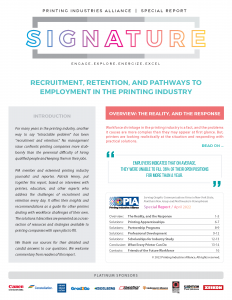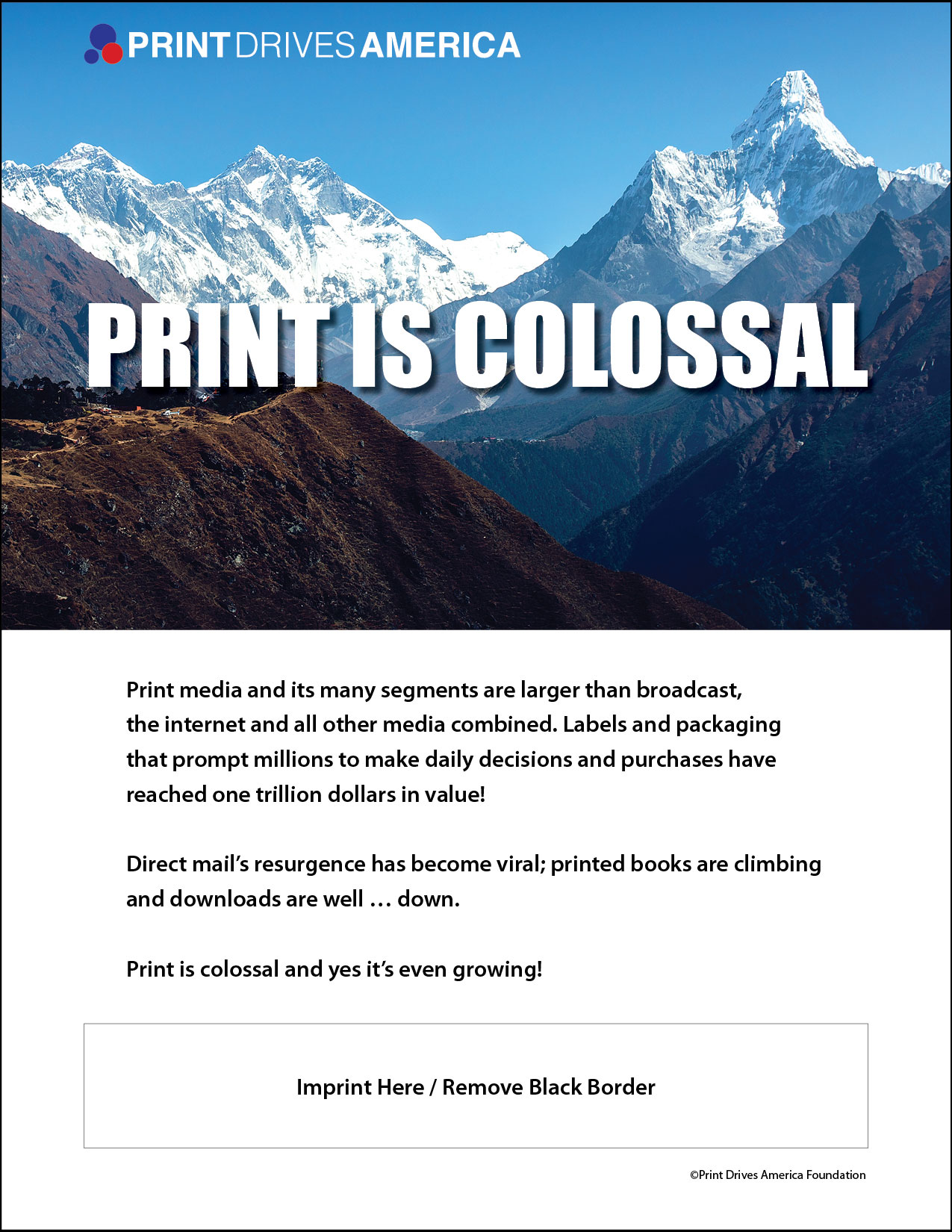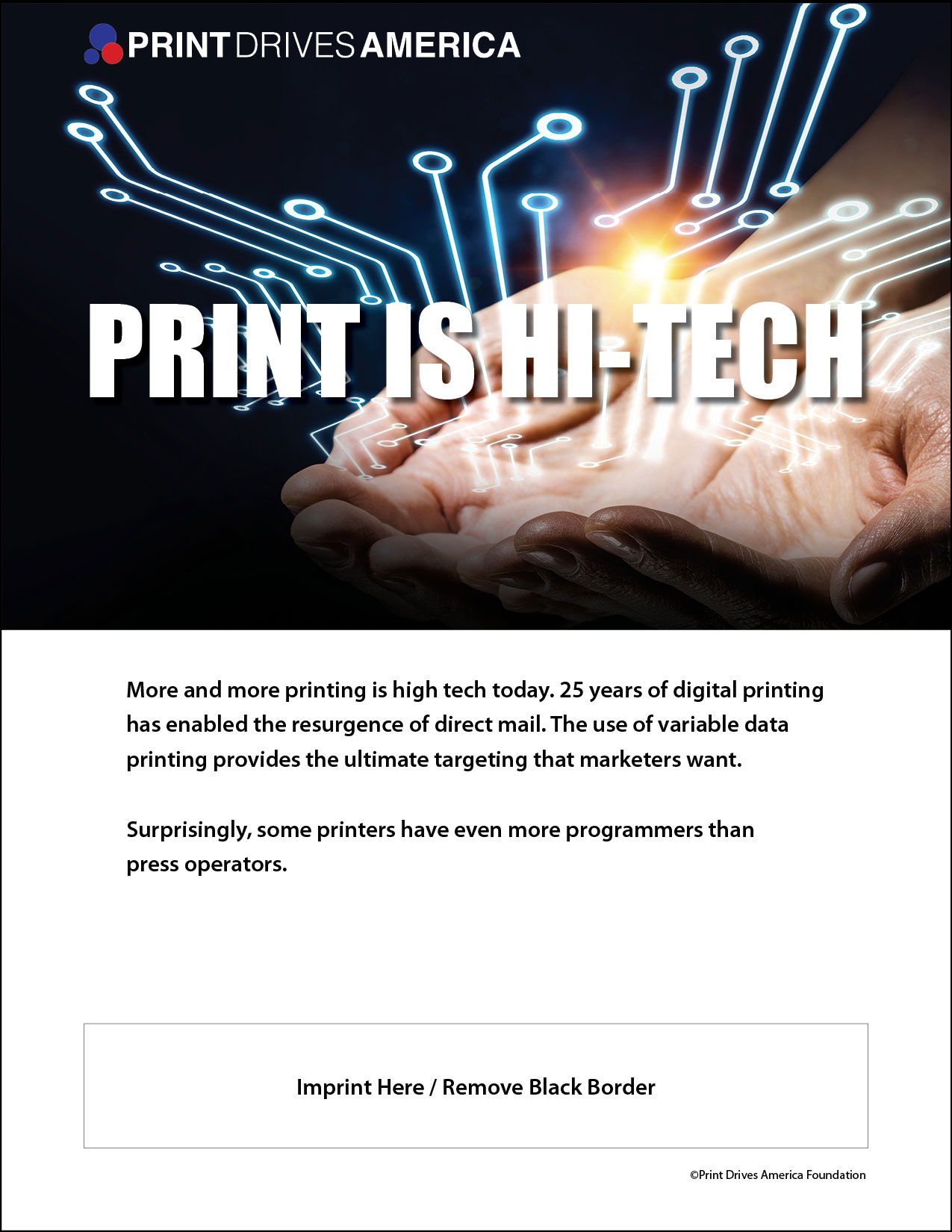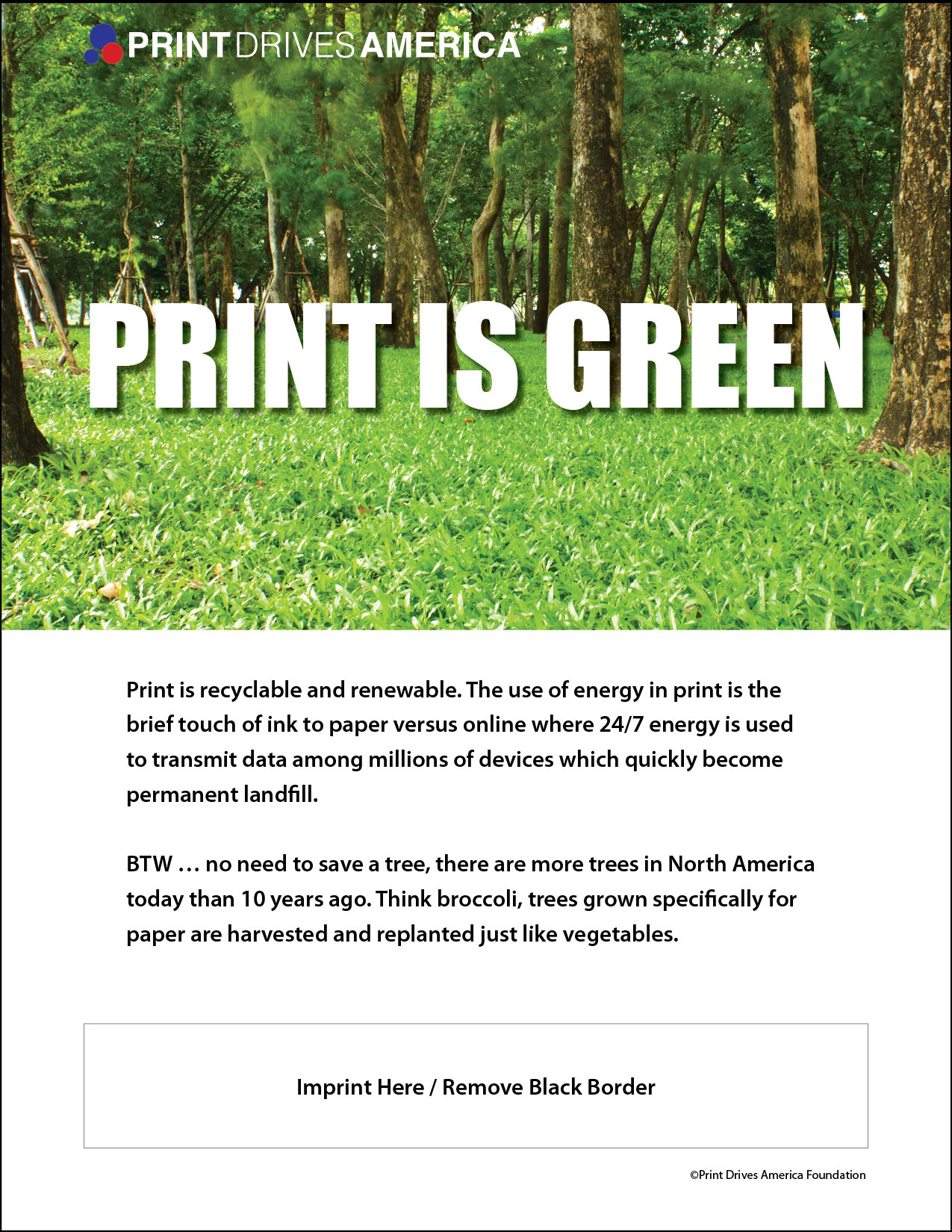By Patrick Henry, Liberty or Death Communications
Conclusion – What Every Printer Can Do – Part 6 of the White Paper: Recruitment, Retention, and Pathways to Employment in the Printing Industry
Conclusion: What Every Printer Can Do
There’s no denying it: the present drumhead-tight labor market has been hard on the printing industry, and the competition for talent may grow stiffer yet. But, if printers harbor no illusions about what they are up against in the near term, they also see the labor shortage as an obstacle that they ultimately can overcome.
Automation will provide some relief as production continues to shift from offset lithographic presses to digital printing systems that require fewer people to operate. But, these people will have to be recruited, and the industry’s analog manufacturing base, with its concurrent need for staffing, is not about to disappear any time soon.
That could mean enduring additional pain on the labor front. When positions remain open for extended periods of time, says Hatteras’s Duerr, “I think it prevents you from growing. It may also force you to outsource more. It’s going to also extend your turnaround times and create bottlenecks – the bottlenecks that get created when you are on a condensed schedule and everybody needs everything on the same schedule.”
Limitations of Cross-Training
Many printers have turned to cross-training as a means of covering vacant positions. But as Almeter found out at Hodgins Engraving, assigning people to multiple roles for this purpose works well only until it doesn’t. During COVID, a reduced volume of jobs and the willingness of her staff to take on other responsibilities enabled the company to operate more efficiently with the people it had. But now, with the staff still lean, the volume is starting to come back.
With it comes the risk of production backups and logjams. Almeter says that on one occasion when an employee who handled shipping called in sick, “I was out shipping all day. I had projects to work on to further the advancement of the company that just got set back a day, because I’m shipping.” However necessary it may be, diverting management personnel from their proper roles to shop-floor tasks “takes away from the goals of the company,” Almeter says.
At BNP Empowered Print, Majerski says that the PIPI survey’s finding about persistently unfilled job openings doesn’t shock him. “We’ve certainly been experiencing that,” he says. “We’re reaching out across the country for those types of people now.” But, he acknowledges that reluctance to relocate and the negative influence of the “Great Resignation” trend make the outreach that much less certain to succeed.
According to Moake of MTSU, this phenomenon of employees walking away from their jobs in record numbers “is still so new that it’s changing our understanding of what it is and how it’s affecting us. Because before, it was the idea that everyone was just leaving, but then, the follow-up was no, everyone’s not leaving, everyone’s trying to level up and move up to better-paying jobs. And so that’s why I think it’s still fluid, and how we’re even defining that term.”
“It’s affecting every industry,” he points out. The “perfect storm” of a low national unemployment rate, COVID-related workforce attrition, and the shift to remote work means employers in all sectors have had to “pivot and adapt” to the new ways in which people are looking at their relationships with their jobs.
In Majerski’s opinion, though, the “Great Resignation” and the damper it puts on hiring won’t last forever.
“We’re living in a difficult time right now,” he concedes. “But finally, people are starting to realize that they do need a job again, and we’re slightly starting to see that light at the end of the tunnel. We’re in a position where we have work – that’s the good news. We have customers that want to print with us. We’ve all just got to navigate this difficult time, and get through it.”
A Myth that Won’t Be Missed
Something else the industry is finally starting to put behind it is the corrosive “print is dead” myth: the misinformed idea that print has no future either as a medium of communication or as a source of employment for newcomers.
Time, as it turns out, was never on the side of this canard. As Regan of Semper explains, the so-called “death” of printing was an event that many people today never actually witnessed for themselves.
“The newer generation is coming up in a world where, when people think of printing, they don’t think of newspapers,” he explains. “Fifteen years ago, when you said ‘printing,’ everyone thought ‘newspapers.’ That’s now out of our culture. The baseline of printing is now no longer based on older styles of printing.” Regan believes that the ubiquity of print and the alternative to “digital overdosing” it offers young people will help keep the appeal of the medium alive and well.
What’s more, even myths about death can die when people stop repeating them. The one pertaining to print is no exception.
At Standard Group, declares Overly, “we’re not allowed to say that in our building.” The word the company focuses on spreading is that “you can make a very good career out of production in print.” She says the company’s poster person for this message is the vo-tech graduate who, just three years after leaving school, “is now operating a million-dollar press” as a full-time Standard employee.
Mark Twain’s famous quip about premature obituaries also applies. As Heisey of H&H Group remarks, “the only place I’ve ever heard ‘print is dead’ is from print publications” trying to refute the idea in editorials. What is dying, he notes, “is getting kids into manufacturing jobs in general.” He puts some of the blame on education models that continue to privilege four-year degrees over the kinds of career training available from trade and vo-tech schools.
The Kids Are Alright
DeAcosta agrees that some people old enough to have seen the sun go down on things like newspapers and telephone books drew the wrong general conclusion about the future of print. But, he also thinks that people in the age group he nurtures as an educator at the Milton Hershey School aren’t making the same mistake.
DeAcosta says that lingering negative publicity “does not really affect the ability to recruit students, because students are pretty open minded” on the subject of printing (even if their parents sometimes need convincing). The real challenge, in his opinion, is that “the industry has not done a good job at promoting itself.”
This has been a source of frustration for White, who notes the lackadaisical attitude he sometimes encounters among the very companies that PGSF is trying to help through its efforts on behalf of education.
“We have a tough time getting in touch with printers,” he reveals, adding that many of them seem not to know that a foundation for print-specific scholarships exists in their industry.
White says, moreover, that judging from what he has seen, “the amount of crossover between the schools working together, collaboration between the schools and the local printers, is nil.”
“It’s amazing that the same printers who are always complaining that I can’t find anybody, aren’t talking to the school down the street to find interns and do work-study and things like that with the students,” he says.
The irony is that printers probably have no better places to recruit from than these hometown spawning-grounds of energetic young talent. Foster of PGAMA has seen just how well reaching out to schools can work.
‘Cool’ It Most Certainly Is
“When I go to an open house for a high school, I take about 200 pieces of entries from our Excellence in Print competition left over from the previous years. And if you just watch the students and parents interact with the printing, it’s amazing. If they’re reluctant to pick something up, I’ll pick up something cool, and I’ll say, ‘Pull those two slots and see what that does,’ and it pops into something 3D.”
“I think that’s how you’re going to attract students into the industry,” Foster says. “It actually helps win the parents over too. I can’t tell you how many times I’ve had comments from students where they say, ‘Wow, this is pretty cool, you can do this in here?’ Just to get their attention, and have the parents see that it’s not just newspapers that we’re talking about.”
Here at the grass roots is where the most of the effort has to be made, Regan emphasizes. Although broadly based initiatives like PGSF do valuable work, “they’re not in your community. You are. What are you doing? You’re feeling this pain. Are you going out and speaking at high schools? Every one of us should become the solution, and stop having the mindset that I’m just going to recruit the people that someone else trained.”
‘Because We’re Printers’
Regan also tells the story of a Semper client with a warehousing facility and an in-house digital printing operation. Semper learned that although the warehouse workers were paid better than the print staff, the turnover in warehouse jobs was much greater – the opposite of what would have been expected, given the disparity in pay.
Regan says that when Semper asked the digital press operators why they stayed on when they could earn more elsewhere, they replied, “Because we’re printers. We have a skill set, and we’re proud of it. We belong to something.” The warehouse workers expressed no such identification or loyalty.
“The printing industry used to have that a lot,” Regan reflects. “Maybe we’ve lost it a little bit.” He thinks reviving the spirit can help the industry attract employees like his client’s printing staff: people who want to be a part of something that they can take pride in. People who are doing what they love. People who are in it for the long haul.
About the Author
Patrick Henry, the director of Liberty or Death Communications, has covered the printing and graphic arts industry as a journalist for nearly 40 years. He holds numerous awards for his industry service and support of professional education. Contact him at pathenry@libordeath.com.
Friends of the Future Workforce
The organizations mentioned in this report may be contacted as follows:
Semper Group: semperllc.com
International Institute of Buffalo: iibuffalo.org
Journey’s End Refugee Services: jersbuffalo.org
Apprenticeship and Training Office of the Pennsylvania Department of Labor and Industry: pacareerlink.pa.gov/jponline/Apprenticeships
Milton Hershey School Career and Technical Education Program: mhskids.org/beyond-mhs/mhs-career-technical-education-program/
Thaddeus Stevens College of Technology Graphic Communications and Printing Technology Program: stevenscollege.edu/academics/associate-degrees/graphic-communications-printing-technology
Susquehanna Litho Club: slc.org
The Mariano Rivera Foundation: themarianoriverafoundation.org
PGAMA, Print[ED], and PrintSIP: pgama.com/areas-of-focus/workforce-development/printing-workforce-training-program-md
The Packaging School at Clemson University: packagingschool.com
The Kathleen Kyme Press Forward Scholarship: dscoop.com/content/Kathleen-Kyme
The Print & Graphics Scholarship Foundation (PGSF): pgsf.org
The Graphic Communications Scholarship, Award and Career Advancement Foundation (GCSF): gcsfny.org
To read the full report, download the Recruitment, Retention, and Pathways to Employment in the Printing Industry white paper. Contact me at tim@printcommunications.org or (716) 691-3211 with any questions.
Tim Freeman, President
Print & Graphic Communications Association





